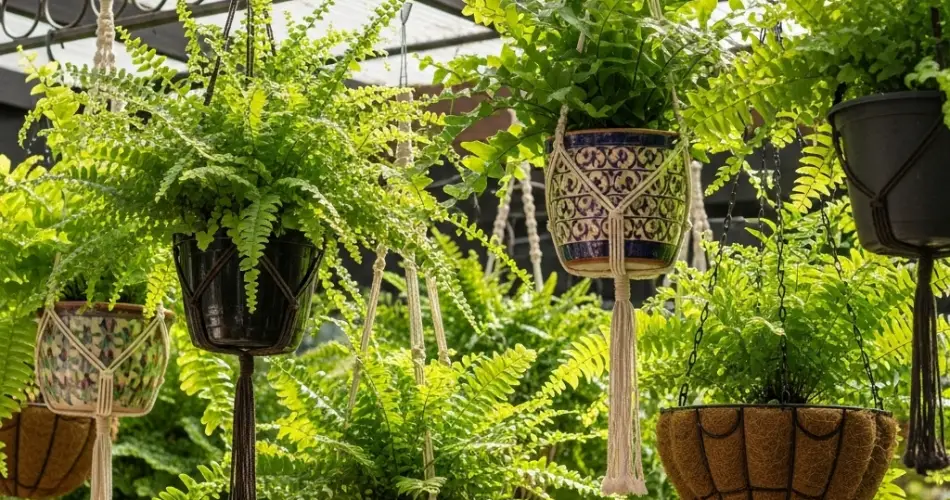Ferns are beloved for their lush, feathery foliage and calming green tones, making them a top choice for indoor greenery. However, when it comes to displaying these shade-loving plants, one question often arises: should you use hanging pots or floor pots? Both options have their benefits and challenges, and choosing the right setup can significantly affect your fern’s health and visual appeal.
Here’s a detailed comparison to help you decide what’s best for your space and your plant.
Hanging Pots: Elevate Your Fern Display
Advantages:
-
Better Air Circulation:
When suspended, hanging pots allow for increased airflow around the foliage, which helps reduce the risk of fungal issues that can arise in damp, stagnant environments. This is especially beneficial for thick or bushy ferns like Boston ferns. -
Saves Space:
Hanging pots are a great solution in smaller homes, apartments, or rooms where floor space is limited. Elevating the plant allows you to green up your home vertically, making use of ceiling hooks, shelves, or wall brackets. -
Dramatic Visual Impact:
Ferns have naturally cascading fronds, which look stunning when allowed to spill over the sides of a hanging planter. This setup gives the plant a more voluminous and ornamental look. -
Pest Control:
Keeping ferns off the ground may reduce the chances of them becoming targets for crawling insects like fungus gnats or ants.
Disadvantages:
-
Watering Challenges:
Watering hanging plants can be a bit tricky, especially if they’re out of easy reach. Overhead watering can lead to dripping and water stains on floors. Hanging pots also dry out faster, especially in warmer environments, requiring more frequent attention. -
Weight Considerations:
Ferns in large hanging pots can be heavy when watered, so secure hanging mechanisms are crucial to avoid damage or accidents. -
Limited Pot Size:
You’re often limited to smaller containers when hanging a plant, which could restrict root development over time unless you repot frequently or prune the roots.
Floor Pots: Traditional and Accessible
Advantages:
-
Easier Maintenance:
Ferns in floor pots are much easier to access for watering, pruning, and repotting. They’re an excellent choice for beginners or anyone who prefers a low-effort maintenance routine. -
Greater Pot Size Flexibility:
Floor pots can be larger and deeper, allowing ferns more space to develop a robust root system, which often leads to fuller, healthier foliage. -
Stable Environment:
Ground-level placement reduces the chance of temperature fluctuations, especially in homes with high ceilings or large windows where heat can rise quickly. -
Decorative Options:
Floor pots can become design features in themselves. From ceramic to woven baskets, the container can complement interior décor while grounding the plant in your space.
Disadvantages:
-
Less Airflow:
Ferns placed on the floor may receive less airflow, especially in corners or near walls, which can lead to mold or fungal buildup in humid conditions. -
Prone to Pests:
Floor pots can be more accessible to pests, including gnats or even household pets who may be tempted to nibble on or disturb the fronds. -
Limited Display of Hanging Fronds:
While ferns look beautiful in floor pots, you may not fully appreciate the cascading nature of the foliage unless the pot is elevated on a plant stand.
Which Fern Varieties Suit Each Option Best?
-
Ideal for Hanging Pots:
-
Boston Fern (Nephrolepis exaltata): Loves to drape over containers, perfect for baskets.
-
Staghorn Fern (Platycerium): Naturally grows in trees and does well mounted or hanging.
-
Maidenhair Fern (Adiantum): Delicate fronds look lovely cascading from a height, though it prefers high humidity.
-
-
Ideal for Floor Pots:
-
Kimberly Queen Fern: More upright and tidy growth, great for larger floor pots.
-
Bird’s Nest Fern (Asplenium nidus): Thrives in medium light with wide leaves that stand tall.
-
Foxtail Fern: While not a true fern, it has a bushier structure that suits sturdy pots.
-
Tips for Success Regardless of Setup
-
Humidity Matters:
Ferns thrive in moist, humid air. Use a humidity tray, group plants together, or run a humidifier nearby to maintain optimal conditions—especially if you live in a dry climate. -
Keep Soil Moist but Not Soggy:
Ferns dislike dry soil but are also susceptible to root rot. Use well-draining potting mixes and ensure pots (whether hanging or floor) have drainage holes. -
Rotate for Balanced Growth:
Regardless of location, rotate your fern regularly so it grows evenly on all sides and avoids leaning toward light sources. -
Protect Surfaces:
Hanging plants can drip, and floor pots can stain if overwatered. Use saucers or trays and be mindful of wood flooring or furniture underneath.
Conclusion: Choose Based on Your Lifestyle and Space
The decision between hanging pots and floor pots for your fern ultimately depends on your environment, design preference, and maintenance routine. Hanging pots offer stunning aesthetics and space-saving benefits, while floor pots provide ease of care and more room for growth. In some cases, alternating between both methods or even using plant stands to elevate floor pots can give you the best of both worlds.
Whichever you choose, with the right care and setup, your fern will flourish and add natural beauty to your home.



